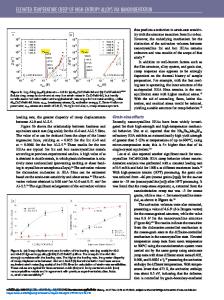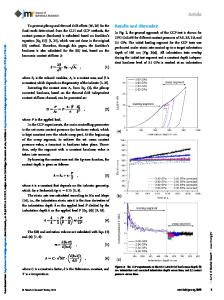Characterization of power-law creep in the solid-acid CsHSO 4 via nanoindentation
- PDF / 828,135 Bytes
- 8 Pages / 584.957 x 782.986 pts Page_size
- 43 Downloads / 812 Views
Characterization of power-law creep in the solid-acid CsHSO4 via nanoindentation Ryan S. Ginder1,a) George M. Pharr2,b) 1
Department of Mechanical, Aerospace and Biomedical Engineering, University of Tennessee Knoxville, Knoxville, Tennessee 37996-2210, USA Department of Materials Science and Engineering, Texas A&M University, College Station, Texas 77843-3003, USA a) Address all correspondence to this author. e-mail: [email protected] b) This author was an editor of this journal during the review and decision stage. For the JMR policy on review and publication of manuscripts authored by editors, please refer to http://www.mrs.org/jmr-editor-manuscripts/. 2
Received: 10 October 2018; accepted: 5 December 2018
A high-temperature nanoindentation system was used to examine the steady state indentation creep behavior of CsHSO4. This high proton conductivity solid-acid material is a candidate for use as a solid-state electrolyte in intermediate temperature fuel cells. Constant strain rate indentation creep tests yielded a stress exponent and a creep activation energy in close agreement with results obtained from previous uniaxial compression testing. The large penetration depths reached during creep testing necessitated validating an indenter area function well beyond depths measurable in fused silica. The developed methodology is material agnostic meaning it can be used for indentation creep measurements in other high creep rate materials. In addition, it is shown how an analysis developed by Bower et al. (Proc. Royal Soc. 441, 97–124, 1993) can be successfully used to convert the indentation creep parameters into the more common material parameters measured in uniaxial creep tests.
Introduction Steady state creep of materials is most often measured in uniaxial tension or compression experiments and is usually described by the power law relation e_ ¼ arn
:
ð1Þ
Here, e_ is the uniaxial steady state strain rate, r is the creep stress, and a and n are the material parameters characteristic of the creep behavior. Although early efforts to quantify timedependent creep deformation via indentation methods date back to the 1960s [1], significant progress was not achieved until the advent of load and depth sensing indentation techniques, i.e., nanoindentation. The appeal of nanoindentation in the measurement of power-law creep parameters stems from its ability to probe small volumes, thereby reducing the amount of material needed to evaluate properties and allowing for the measurement of very thin films and small particles. One of the first successes in studying creep by instrumented indentation methods is the work of Chu and Li [2]. Using cylindrical, flat punch indenters with diameters varying from 0.173 to 0.730 mm, these investigators experimentally showed that steady state impression creep (flat punch indentation) of
ª Materials Research Society 2019
succinonitrile exhibits the same stress dependence as that measured in uniaxial compression [2]. Subsequently, Mayo and Nix used a nanoindentation system equipped with
Data Loading...











